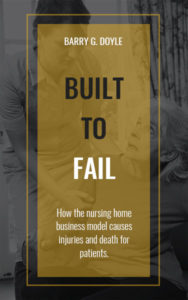The Illinois Department of Health has cited and fined Meadowbrook Manor – Naperville when a resident with severe cognitive impairment and eight previous unwitnessed falls in his room had a ninth unwitnessed fall that caused a brain injury, massive seizure, and ultimately his death. Despite the resident’s care plan requiring increased supervision and monitoring to prevent self-transfers, staff left him alone in his room where he fell again while they were in the dining room.
The resident in question was admitted to the facility with multiple serious conditions including a history of falls, previous traumatic brain bleeding, vascular dementia with moderate agitation, hallucinations, unsteadiness on feet, difficulty walking, and cognitive deficits. His assessment showed he was severely cognitively impaired and required staff assistance with transfers. His medical record did not show any history of seizures.
The resident’s care plan, created shortly after admission, identified him as being at risk for falls related to “confusion, deconditioning, gait and balance problems, poor comprehension, unaware of safety needs, dementia, hallucinations, and recurrent falls.” The care plan included multiple interventions designed to prevent falls, specifically including instructions to “conduct rounds,” “toilet resident and place in dining room, hallways or nurses’ station for more visual supervision,” and “increase supervision in the room. Monitor any attempt of self transfer.”
Despite these care plan requirements, the resident experienced eight unwitnessed falls in his room over a seven-month period. The fall incident reports documented falls occurring regularly, with all incidents showing the resident “was trying to self-transfer in and out of his wheelchair” when he fell. Each time, staff found him on the floor after the fact, meaning no one had been present to supervise him or prevent the fall.
Around 12:35 PM on the day of the incident, the resident had his ninth unwitnessed fall in his room. He was found “sitting on the floor facing his wheelchair with his legs flexed and holding on to his wheelchair” after attempting to stand up from his wheelchair unassisted. His assigned nursing assistant stated in an incident report: “When the incident happened, I did not witness it happening. I was helping in the dining room with passing trays and feeding residents.” His assigned nurse also stated: “At the time of fall, I was at the nurse’s station. Fall not witnessed.”
A nurse assessed the resident after finding him on the floor and initiated neurological checks. The nurse later explained the resident “was at a high risk for falls because he had a known history of falls, was confused, and impulsive.” The neurological assessment appeared normal and the resident “did not appear to have any injury or change in condition.” Staff then assisted him into his wheelchair and transported him to the main dining area for lunch, where he was supervised.
Nearly three hours later, at 3:15 PM, staff noticed a bump on the right side of the resident’s head. The nurse practitioner was notified and gave orders to send the resident to the hospital for further evaluation. Routine paramedics arrived to transfer him. However, as they were moving the resident into the ambulance, he “started to have a massive seizure.” The paramedics immediately contacted emergency paramedics for additional support, and the resident was transported to the hospital.
Hospital notes documented the resident was admitted “post-fall with a suspected significant head trauma likely subdural hematoma, acute encephalopathy, seizures, and dilated left pupil and flaccid left side.” The hospital record showed the resident “remained unresponsive and family elected for hospice care.” The resident died after being admitted to inpatient hospice care without additional diagnostic testing.
The director of nursing acknowledged the resident “was monitored after his fall per protocol, and at 3:15 PM, he was noted with a bump to his head.” She stated the
resident “was admitted for altered mental status, seizure, and traumatic brain injury” and explained “the facility felt they could not determine if the resident’s acute change in medical condition was related to his fall incident because the facility elected to admit the resident into inpatient hospice care and not proceed with additional diagnostic testing.”
The director of nursing stated the resident “had a known history of recurrent falls and head trauma with an intracranial bleed” and claimed “fall incidents were investigated and fall prevention interventions were implemented in the residents’ plan of care.” However, the resident had experienced nine unwitnessed falls in his room over seven months, all involving attempts to self-transfer from his wheelchair – the exact behavior his care plan required staff to monitor and prevent.
The nurse practitioner explained she “expected facility staff to complete a root cause analysis after a resident’s fall to investigate the cause and then implement interventions to prevent reoccurrences.” The facility’s own policy stated that “if falling recurs despite initial interventions, staff will implement additional or different interventions.” Yet despite eight previous unwitnessed falls in his room with the same cause – attempting to self-transfer from his wheelchair – the facility never modified its approach to actually provide the increased supervision and monitoring his care plan required.
One of our core beliefs is that nursing homes are built to fail due to the business model they follow and that unnecessary accidental injuries and wrongful deaths of nursing home residents are the inevitable result. Our experienced Chicago nursing home lawyers are ready to help you understand what happened, why, and what your rights are. Contact us to get the help you need.


